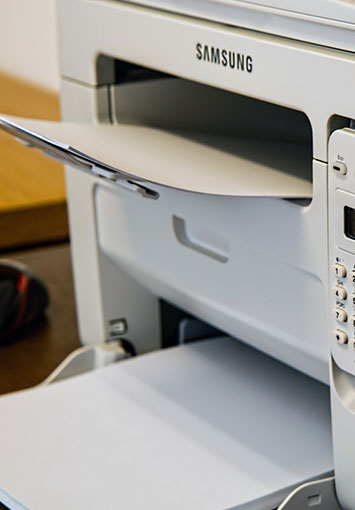How to Convert a Scanned Document to PDF
 Convert Scanned Document to PDF" width="355" height="510" />
Convert Scanned Document to PDF" width="355" height="510" />
Whether you’re archiving important paperwork, sharing files across different platforms, or ensuring compatibility for future reference, understanding how to convert your scanned documents into PDFs is key.
This article will guide you through a few simple but effective methods to achieve this with both free and paid software, ensuring your scanned documents are not only accessible but also secure and easy to distribute.
Why PDF?
Among various digital formats, PDF (Portable Document Format) stands out as the most versatile and widely accepted format for scanned documents. The PDF format was developed in the early 1990s, and since has become a global standard for the distribution and exchange of electronic documents. This is not just due to its widespread compatibility but also because of a range of features that cater to the needs of both individual and business users. Choosing PDF as the format for your scanned documents offers numerous benefits:
- Universal Compatibility: PDFs can be opened on almost any device, maintaining consistent formatting and layout across different platforms and operating systems.
- Compact and Efficient: PDF files can compress high-quality documents into smaller file sizes, making them easier to store and share.
- Enhanced Security: PDFs support advanced security features, including password protection, encryption, and digital signatures, safeguarding sensitive information.
- Searchability and Accessibility: With OCR technology, scanned PDFs become searchable, making it easy to find and retrieve information.
- Editing and Integration: PDFs allow for easy integration of various types of content (text, images, hyperlinks) and offer editing capabilities for further customization.
These attributes make PDFs a highly versatile and reliable choice for digitizing and managing documents in both personal and professional use.
Choosing the Right Tools
Selecting the right software for converting scanned documents to PDF is a decision that hinges on understanding the diverse needs and capabilities of different tools. Here’s a deeper dive into how to choose the best fit for your requirements:
Free vs Paid Software
Free Tools are ideal for individuals or small businesses with basic conversion needs. These tools often offer essential functionalities like merging scans, basic editing, and straightforward PDF conversion.
- NAPS2 (Not Another PDF Scanner 2): A user-friendly tool ideal for individuals or small businesses. It offers basic scanning to PDF capabilities, with some editing options.
- PDF24 Creator: Provides essential functions like merging, splitting, and basic editing of PDF files. Suitable for small-scale use.
- Scan2PDF: Simple and straightforward, ideal for quickly turning paper documents into PDFs without complex features.
- PaperScan Free Edition: Offers basic scanning to PDF capabilities with some image adjustment tools, suitable for personal or small business use.
Paid Software is designed for more demanding business environments. They typically include advanced features like batch processing, higher security options, and improved format compatibility.
- Adobe Acrobat Pro: A comprehensive solution offering OCR, batch processing, and advanced editing features. Ideal for businesses requiring high-level document management capabilities.
- ABBYY FineReader: Known for its powerful OCR technology, it’s perfect for enterprises that need to convert scanned documents into editable and searchable PDFs.
- Kofax Power PDF: Offers robust features for creating, converting, editing, and sharing PDFs, suitable for both individual professionals and businesses.
- Nitro Pro: Provides comprehensive PDF creation and editing tools with an emphasis on user-friendliness and efficiency, great for medium to large businesses.
Do You Need OCR?
Optical Character Recognition (OCR) is a technology that converts different types of documents, such as scanned paper documents or PDF files, into editable and searchable data. Deciding whether you need OCR capabilities depends on how you intend to use your scanned documents once they have been converted to PDF.
When You Would Need OCR:
- Document Editing: If you need to modify the text in scanned documents.
- Searchability: When you want to search for specific text within a large volume of scanned documents.
- Data Extraction: Useful for extracting information from forms or invoices.
- Archiving: Simply storing scanned copies of documents where editing or text search is not required.
- Image-Only Documents: For documents where the text isn’t a primary element, like photo albums or image-based reports.
Step-by-Step Conversion Guide
Converting paper documents to digital PDF files is a straightforward process, but it requires careful attention to detail to ensure the best quality and accuracy. This step-by-step guide will walk you through the conversion process using different software tools. Whether you’re dealing with a handful of documents for personal use or managing a large volume of paperwork for your business, these instructions will help you efficiently transform your physical documents into versatile, secure, and easily accessible PDFs.
Using Adobe Photoshop (Paid Software)
- Open the Image in Photoshop:
- Start by opening Adobe Photoshop.
- Click on File in the menu bar, then select Open.
- Browse to the location of the image you want to convert and open it.
- Make Necessary Edits (Optional):
- Before converting, you can edit the image as needed. This might include cropping, adjusting colors, or applying filters.
- Once you are satisfied with the image, proceed to the next step.
- Convert to PDF:
- Go to File in the menu bar.
- Choose Save As. or Save a Copy. (depending on your Photoshop version).
- In the Save As dialog box, select the location where you want to save the file.
- In the Format dropdown menu, select Photoshop PDF .
- Configure PDF Settings:
- Once you select Photoshop PDF, a new dialog box will appear with PDF options.
- You can choose from various presets depending on your needs. For instance, High Quality Print is suitable for printing, while Smallest File Size is better for online use.
- Adjust the settings as necessary. If you’re not sure, the default settings are usually a good starting point.
- Save the PDF:
- Click Save after adjusting your settings.
- You might see another dialog box with more options. Review these and make changes if needed. For simple conversions, the default settings are typically fine.
- Click Save PDF .
- Review the PDF:
- After saving, it’s a good idea to open the PDF to ensure it looks as expected.
- You can open it in a PDF viewer like Adobe Acrobat or your web browser.
Using Adobe Acrobat Pro DC (Trial)
- Open Adobe Acrobat:
- If you don’t have Acrobat, you can download a trial from Adobe’s official website and choose the version that fits your needs.
- Create a New PDF:
- In Adobe Acrobat, go to the File menu in the top-left corner.
- Select Create and then choose PDF from File. . This will open a file selection dialog.
- Select Your Image:
- In the dialog box, navigate to the folder where your image is stored.
- Select the image file you wish to convert. Acrobat supports various image formats like JPG, PNG, BMP, GIF, and TIFF.
- Click Open to import the image into Acrobat.
- Image to PDF Conversion:
- Once you select the image, Acrobat will automatically convert it into a PDF.
- The conversion process usually takes just a few seconds.
- Edit the PDF (Optional):
- After conversion, you can use Acrobat’s editing tools to make changes to the PDF if necessary. This could include adding text, annotations, or combining multiple images into one PDF.
- To edit, use the tools available in the right-hand pane or under the Tools tab.
- Save the PDF:
- Once you’re satisfied with the document, go to File > Save As .
- Choose a destination for your PDF and enter a file name.
- Click Save .
- Review the PDF:
- After saving, it’s a good practice to open the PDF to ensure everything looks as expected.
- You can view it in Acrobat or any other PDF reader.
Using ABBYY FineReader (Trial)
- Open ABBYY FineReader:
- If you don’t have ABBYY FineReader installed, you can download it from ABBYY’s official website.
- Open the Image File:
- Click on File in the top menu.
- Choose Open or Open Image .
- Browse to the location of the image file you want to convert and select it. ABBYY FineReader supports various image formats like JPG, PNG, BMP, and TIFF.
- Recognize the Text (Optional):
- If your image contains text and you want to use FineReader’s OCR feature, click on the Recognize button. This will convert any text in the image into editable and searchable content in the PDF.
- You can choose the language of the text for better accuracy in recognition.
- Edit and Arrange the Document (Optional):
- Before converting, you have the option to edit the document. This might include adjusting layout, correcting OCR errors, or editing the text directly in FineReader.
- You can also rearrange pages or add pages from other files if needed.
- Save as PDF:
- Once you are ready to convert, go to File > Save As .
- In the Save As dialog, choose PDF Document as the format.
- Choose your desired PDF settings. FineReader offers various options, like saving as an image-only PDF or a searchable PDF with editable text.
- Finalize the Conversion:
- Select the location where you want to save the new PDF.
- Click Save to complete the conversion.
- Review Your PDF:
- After conversion, it’s a good idea to open the PDF to ensure it has been converted as expected.
- Check the quality of the OCR if you used that feature.
Using PDF24 Creator (Free)
- Install PDF24 Creator:
- If you haven’t already installed PDF24 Creator, download it from the official PDF24 website and follow the installation instructions.
- Launch PDF24 Creator:
- Open PDF24 Creator on your computer.
- Import Your Image:
- You can import your image file in a couple of ways:
- Drag and drop the image file directly into the PDF24 Creator interface.
- Alternatively, click on the File menu, select Import from file. , and then navigate to and open your image file.
- Image File in PDF24 Creator:
- Once the image file is imported, it will appear in the PDF24 Creator interface as a new project.
- Edit the Image (Optional):
- If you need to make any adjustments to the image before converting it to PDF, you can use the editing tools provided in PDF24 Creator. This might include cropping, rotating, or rearranging the page order if you’re converting multiple images.
- Convert to PDF:
- Click on the “Save as PDF” icon or button. This will convert the image to PDF format.
- You can also choose the ‘Merge’ function if you have multiple images and you want to combine them into a single PDF.
- Save the PDF:
- A window will pop up asking you to choose a destination to save the PDF file.
- Name your file and choose where you want to save it on your computer.
- Click Save .
- Review Your PDF:
- After saving the file, open the PDF to ensure it looks as expected.
- Verify that all the images are correctly formatted and that the quality is satisfactory.
Using Adobe’s Online PDF Converter (Free, Online)
Adobe also offers an online document to pdf converter. To convert an image to a PDF using Adobe’s free online PDF converter, you can follow these steps:
- Go to Adobe’s PDF Converter:
- Visit the Adobe PDF conversion webpage at https://www.adobe.com/acrobat/online/convert-pdf.html
- Upload Your Image:
- Look for an option to upload or drag and drop your image file. The online tool typically supports various image formats like JPG, PNG, BMP, etc.
- Convert the Image:
- After uploading the image, the tool will give you options or settings for the conversion process. Adjust these as needed.
- Download the PDF:
- Once the image is converted, you should have the option to download the new PDF file to your computer.
- Review the PDF:
- Check the downloaded PDF to ensure the conversion went smoothly and the image quality is preserved..
This online tool is handy for quick conversions without the need for downloading or installing any software.
Outsourcing for Efficiency
For businesses with a substantial volume of documents to convert to PDF, outsourcing this task can be immensely beneficial.
At SecureScan, we specialize in handling large-scale scanning projects efficiently and accurately. Our expertise ensures high-quality results, while our advanced equipment processes documents rapidly, making the entire process cost-effective for your business.
By delegating this task to us, your team can focus on core business activities, confident in the knowledge that your document conversion is in expert hands. We prioritize security and compliance, ensuring your data is handled with the utmost care. Opting for our service not only streamlines your document management process but also enhances your overall operational efficiency.
For more information, contact us or get a free quote for your next scanning project from one of our scanning technicians.
Get in touch with SecureScan
We're here to help you tackle your paper problems. Contact us for more information, and someone will get back to you as soon as possible.
Learn More About Our Services
SecureScan offers convenient and secure document scanning services to help you modernize your business's paper processing workflows.
Read More

Accurate and organized recordkeeping is central to the work that police departments, sheriffs’ offices, probation offices, and other law enforcement agencies perform every day. Officers, detectives, prosecutors, and administrative staff rely on quick, secure access to a wide variety of records, whether in the office or out in the field, to perform their duties effectively.

Managing medical records has always been a challenge for healthcare providers, but the shift towards paperless recordkeeping is greatly simplifying the process. With many practices moving away from traditional paper recordkeeping, Electronic Medical Record (EMR) systems are becoming the new standard, offering streamlined management of patient charts, improved accuracy in documentation, and enhanced accessibility to

Paperwork is an inevitable part of running a business. From invoices and contracts to employee records and client information, the number of documents a business needs to keep track of can be overwhelming. Some business records contain sensitive information, making it essential that these documents are handled with extra care. It’s also important that these

 Convert Scanned Document to PDF" width="355" height="510" />
Convert Scanned Document to PDF" width="355" height="510" /> Convert Scanned Document to PDF" width="355" height="510" />
Convert Scanned Document to PDF" width="355" height="510" />

